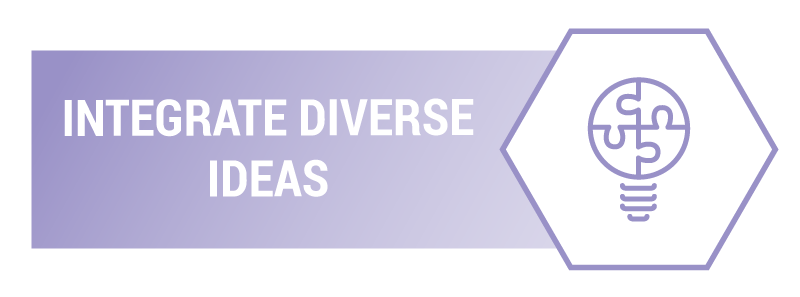Domains of Business Agility
- Responsive Customer-Centricity
- / Fiercely Champion The Customer
- / Sense & Respond Proactively
- / Integrate Diverse Ideas
- Engaged Culture
- / Cultivate A “Learning Organization”
- / Engage Transparently & Courageously
- / Embed Psychological Safety
- / Act As One
- Value-Based Delivery
- / Unleash Workflow Creatively
- / Prioritize. Prioritize. Prioritize.
- / Deliver Value Sooner
- / Seize Emergent Opportunities
- Flexible Operations
- / Adapt Strategies Seamlessly
- / Fund Work Dynamically
- / (Re)Organize Structures Fluidly
- / Balance Governance And Risk
- People-First Leadership
- / Foster Authentic Relationships
- / Empower With Accountability
- / Realize People’s Potential
Bold new ideas are the first step toward innovation and disruption. The next big idea could come from anyone in your organization. This means that organizations must aggressively invest in the ability to seek out and openly discuss diverse ideas from anyone in the organization — especially those closest to the customer. There is always more than one way to think about something, and each person brings a perspective forged through their unique identity, culture, and experiences.
To truly embrace business agility, organizations must intentionally encourage diversity of thought. However, seeking out and discussing diverse ideas is not enough. Organizations need to have the ability to integrate new and emergent ideas into their experiments, strategies, roadmaps, and plans in a seamless way that is welcomed by teams and doesn’t cause organizational chaos.
Primary Behaviors
The following 4 behaviors strongly contribute to the ability to integrate diverse ideas.
B10: Everyone is invited to speak-up with ideas and opportunities: In both formal and informal discussions, people in the organization work to include everyone else in the conversation. Ideas and opportunities are actively sought after and welcomed from anyone and everyone. People notice if a conversation is being dominated by one or a few voices, and respectfully find ways to invite others to contribute as well.
B11: Leaders encourage and fund teams to take worthwhile risks: Teams are not always expected to “play it safe.” They are given the time, support, and (most importantly) funding to explore ideas and opportunities with no guarantee of success but which may be of value to customers and the business.
B12: Everyone pursues opportunities for cross pollination with other groups and organizations: Channels both formal and informal encourage cross-communication on a frequent basis at all levels of the organization. Ideas and insights multiply when shared across the organization. Individuals and teams share challenges with other parts of the organization, often finding that a particular problem has already been solved somewhere else. Experiments and their outcomes (both positive and negative) are shared so that other groups may learn and apply the lessons as well.
B13: Leaders deliberately staff diverse teams: Leaders build teams with demographic diversity (gender, race, sexual orientation, etc.); experiential diversity (affinities, abilities, skills, experience); and cognitive diversity (how we approach problems and think about things)


